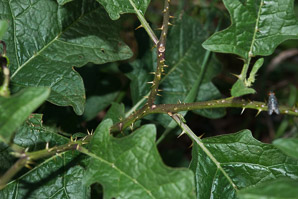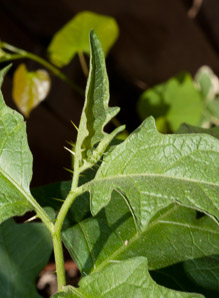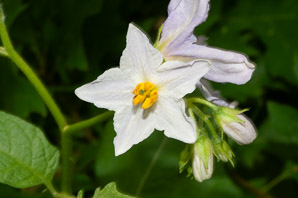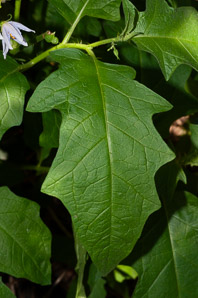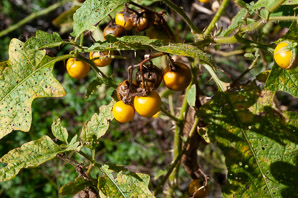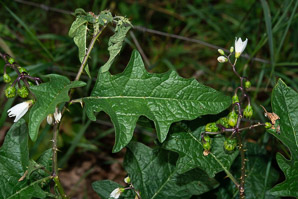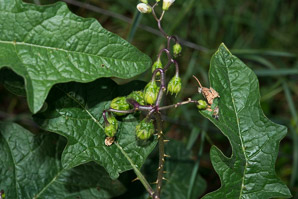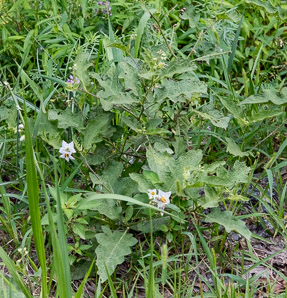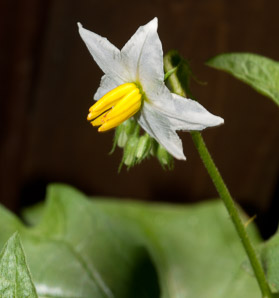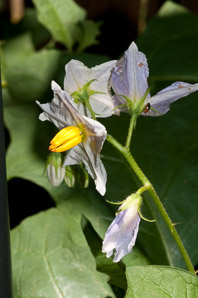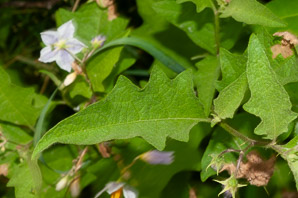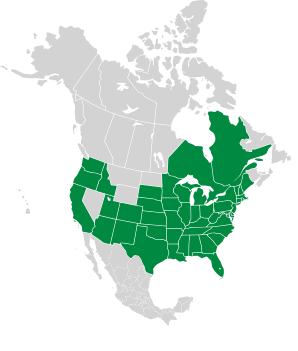
|
Solanum carolinense L. Carolina horsenettle, horsenettle
Carolina horsenettle is a North American native, considered an invasive in many southern habitats. Identification: Plants are up to 3′ (1 m) tall, with round, hairy, spiny stems that become a bit woody with age. Leaves are alternate, on petioles (stems) up to ¾″ (2 cm) long. They are elliptic-oblong to ovate. Smaller leaves are unlobed, while larger ones are often lobed, vaguely resembling oak leaves. They are up to 8″ (20 cm) × 2½″ (7 cm), and emit a potato-like odor when crushed. Flowers appear in small racemes at angles to the main stem. The racemes lengthen when the flowers begin producing fruit. Each flower is white to lilac to purple in color, a five-pointed star, with five yellow stamens like a miniature bunch of bananas in the center. They appear from May to October. Berries are green when immature, streaked with different shades of green, turning yellow when mature. Online References:
The Connecticut Botanical Society's Connecticut wildflowers site Invasive.org, Center for Invasive Species and Ecosystem Health 7/21/2013 · Gibbet Hill, Groton, Massachusetts · ≈ 9 × 6″ (22 × 15 cm) 6/13/2011 · Alexandria, Virginia · ≈ 4 × 6″ (10 × 15 cm) 6/13/2011 · Alexandria, Virginia · ≈ 7 × 4½″ (17 × 11 cm) 7/7/2012 · Gibbet Hill, Groton, Massachusetts · ≈ 4½ × 3″ (11 × 7.9 cm)
Solanum carolinense description by Thomas H. Kent, last updated 25 May 2020. © FloraFinder.org. All rights reserved. |
6/13/2011 · Alexandria, Virginia · ≈ 6 × 9″ (14 × 22 cm) 10/2/2010 · Near Huckleberry Ridge State Forest, Greenville/Orange, New York · ≈ 8 × 5″ (19 × 13 cm) 7/21/2013 · Gibbet Hill, Groton, Massachusetts · ≈ 11 × 7″ (28 × 18 cm) 7/21/2013 · Gibbet Hill, Groton, Massachusetts · ≈ 9 × 6″ (22 × 15 cm) 7/27/2016 · Michaux State Forest, Caledonia State Park, Fayetteville, Pennsylvania 6/13/2011 · Alexandria, Virginia · ≈ 3 × 4½″ (7.9 × 11 cm) 6/13/2011 · Alexandria, Virginia · ≈ 3½ × 5″ (9.2 × 13 cm) 7/7/2012 · Gibbet Hill, Groton, Massachusetts · ≈ 7 × 4½″ (17 × 11 cm) Range:
|
